Gujarat Board GSEB Textbook Solutions Class 8 Maths Chapter 1 Rational Numbers Textbook Questions and Answers.
Gujarat Board Textbook Solutions Class 8 Maths Chapter 1 Rational Numbers Ex 1.1
Question 1.
Using appropriate properties find:
(i) \(-\frac{2}{3} \times \frac{3}{5}+\frac{5}{2}-\frac{3}{5} \times \frac{1}{6}\)
(ii) \(\frac{2}{5} \times\left(-\frac{3}{7}\right)-\frac{1}{6} \times \frac{3}{2}+\frac{1}{14} \times \frac{2}{5}\)
Solution:
(i) \(-\frac{2}{3} \times \frac{3}{5}+\frac{5}{2}-\frac{3}{5} \times \frac{1}{6}\)
= \(\left[-\frac{2}{3} \times \frac{3}{5}+\left(\frac{-3}{5}\right) \times \frac{1}{6}\right]+\frac{5}{2}\)
(Using commutative)
= \(\left[-\frac{2}{3} \times \frac{3}{5}+\left(\frac{-3}{5}\right) \times \frac{1}{6}\right]+\frac{5}{2}\) = \(\frac { 5 }{ 2 }\)
= \(\left(\frac{-3}{5}\right)\left[\frac{2}{3}+\frac{1}{6}\right]+\frac{5}{2}\) (Using distributivity)
= \(\left(\frac{-3}{5}\right)\left[\frac{4+1}{6}\right]+\frac{5}{2}=\left(\frac{-3}{5}\right)\left[\frac{5}{6}\right]+\frac{5}{2}\)
= \(\frac{-3}{5} \times \frac{5}{6}+\frac{5}{2}=\frac{-1}{2}+\frac{5}{2}=\frac{-1+5}{2}=\frac{4}{2}\) = 2
(ii) \(\frac{2}{5} \times\left(-\frac{3}{7}\right)-\frac{1}{6} \times \frac{3}{2}+\frac{1}{14} \times \frac{2}{5}\)
= \(\frac{2}{5} \times\left(\frac{-3}{7}\right)-\frac{1}{4}+\frac{1}{14} \times \frac{2}{5}\)
= \(\frac{2}{5} \times\left(\frac{-3}{7}\right)+\frac{1}{14} \times \frac{2}{5}-\frac{1}{4}\)
(Using commutative)
= \(\frac{2}{5}\left[\frac{-3}{7}+\frac{1}{14}\right]-\frac{1}{4}\) (Using distributivity
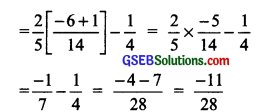
Question 2.
Write the additive inverse of each of the following:
- \(\frac { 2 }{ 8 }\)
- \(\frac { -5 }{ 9 }\)
- \(\frac { -6}{ -5 }\)
- \(\frac { 2 }{ -9 }\)
- \(\frac { 19 }{ -6 }\)
Solution:
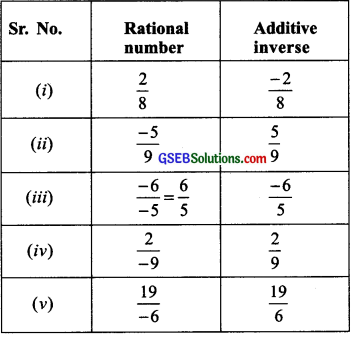
Question 3.
Verify that – (-x) = x for:
- x = \(\frac { 11 }{ 15 }\)
- x = – \(\frac { 13 }{ 17 }\)
Solution:
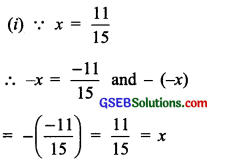

Question 4.
Find the multiplicative inverse of the following:
- – 13
- \(\frac { -13 }{ 19 }\)
- \(\frac { 1 }{ 5 }\)
- \(\frac { -5 }{ 8 }\) × \(\frac { -3 }{ 7 }\)
- -1 × \(\frac { -2 }{ 5 }\)
- -1
Solution:
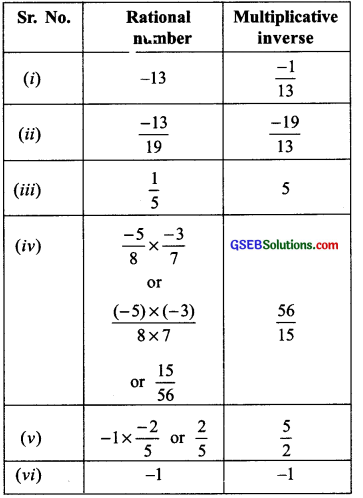
![]()
Question 5.
Name the property under multiplication used in each of the following:
- \(\frac { 1 }{ 2 }\) × 1 = 1 × \(\frac { -4 }{ 5 }\) = – \(\frac { 4 }{ 5 }\)
- – \(\frac { 13 }{ 17 }\) × \(\frac { 13 }{ 17 }\)
- \(\frac{-19}{29} \times \frac{29}{-19}\) = 1
Solution:
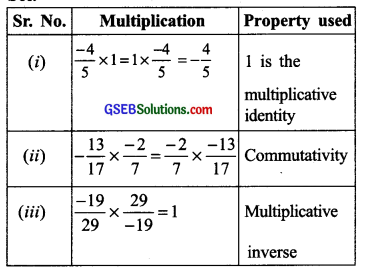
Question 6.
Multiply \(\frac { 6 }{ 13 }\) by the reciprocal of \(\frac { -7 }{ 16 }\)
Solution:
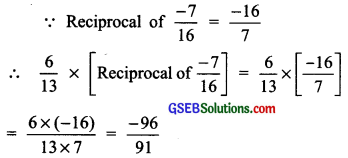
Question 7.
Tell what property allows you to compute
\(\frac { 1 }{ 3 }\) ×\(\left(6 \times \frac{4}{3}\right)\) as \(\left(\frac{1}{3} \times 6\right) \times \frac{4}{3}\)
Solution:
In computing \(\frac { 1 }{ 3 }\) ×\(\left(6 \times \frac{4}{3}\right)\) as \(\left(\frac{1}{3} \times 6\right) \times \frac{4}{3}\) , we use the associativity.
![]()
Question 8.
Is \(\frac { 8 }{ 9 }\) the multiplicative invers of -1\(\frac { 1 }{ 8 }\) ?
Why or Why not?
Solution:
Since, -1\(\frac { 1 }{ 8 }\) = \(\frac { -9 }{ 8 }\) and \(\frac { 8 }{ 9 }\) × \(\frac { 8 }{ 9 }\) × \(\frac { -9 }{ 8 }\) = -1
[Which is not equal to 1]
∴ \(\frac { 8 }{ 9 }\) is not the multiplicative invers of \(\frac { -9 }{ 8 }\)
[∴ The product of \(\frac { -9 }{ 8 }\) and its multiplication invers must be equal to 1]
Question 9.
Is 0.3 the multiplicative inverse of 3 \(\frac { 1 }{ 3 }\) ? Why or why not?
Solution:
0.3 = \(\frac { 3 }{ 10 }\) and 3\(\frac { 1 }{ 3 }\) = \(\frac { 10 }{ 3 }\)
and, multiplicative invers of 3 \(\frac { 1 }{ 3 }\) or \(\frac { 10 }{ 3 }\) = \(\frac { 3 }{ 10 }\) = 0.3
∴the multiplicative inverse of 3\(\frac { 1 }{ 3 }\) is 0.3
Question 10.
Write:
- The rational number that does not have a reciprocal.
- The rational numbers that are equal to their reciprocals.
- The rational number that is equal to its negative.
Solution:
- The rational number zero (0) does not have a reciprocal.
- The rational numbers 1 and (-1) are equal to their reciprocals respectively.
- ∵ [A rational number] + [Negative of the rational number] = 0 [ ∵ [0] = [0] = 0 ]
So, Negative of 0 is 0. Hence, 0 is equal to its negative.
![]()
Question 11.
Fill in the blanks:
- Zero has _______ reciprocal
- The numbers _______ and _____ are their own reciprocals.
- The reciprocal of -5 is ______
- Reciprocal of \(\frac { 1 }{ x }\) , where x ≠ 0 is ______.
- The reciprocal of a positive rational number is always a _______
- The reciprocal of a positive rational number is ______
Solution:
- Zero has no reciprocal.
- The numbers 1 and -1 are their own reciprocals.
- The reciprocal of -5 is \(\frac { -1 }{ 5 }\)
- The reciprocal of \(\frac { 1 }{ x }\) where x ≠ 0 is x.
- The product of two rational numbers is always a rational number.
- The reciprocal of a positive rational number is positive.